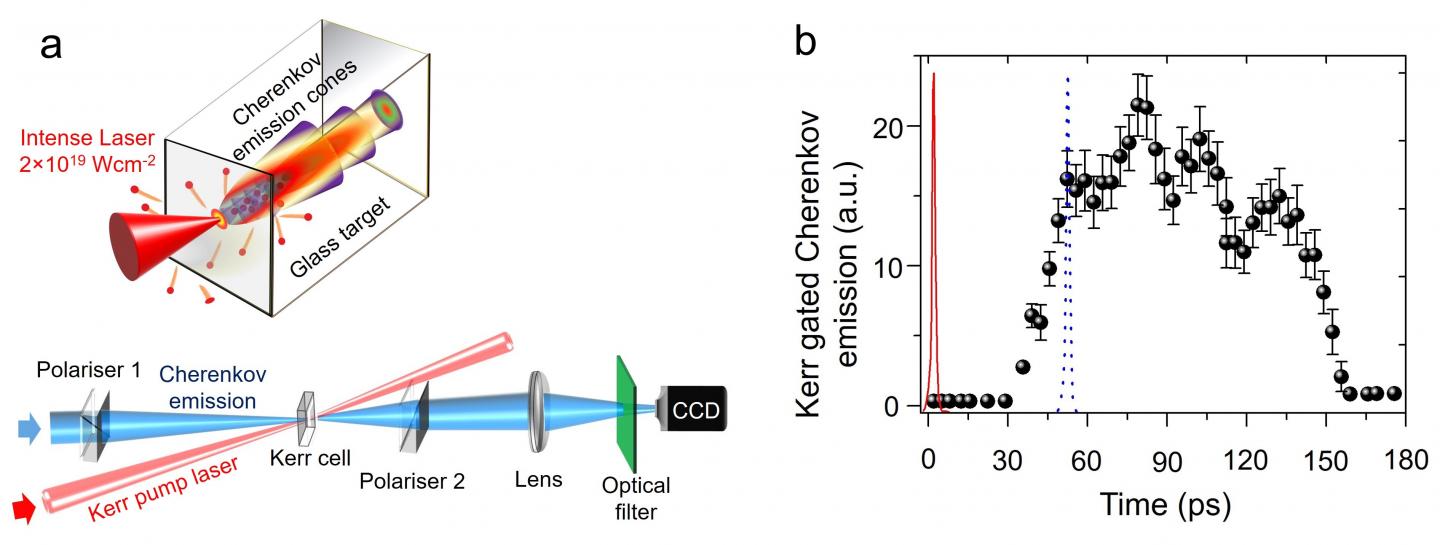Author:
Tata Institute of Fundamental Research
Date
02/06/2018

The table-top laser experiment at the Tata Institute of Fundamental Research, Mumbai. (a) A high power laser pulse creates mega-ampere electron current pulses. Cherenkov emission in the form of cones is emitted by these electrons traveling faster than light in glass. (b) the time trace of the Cherenkov emission measured in the experiment.
Living life in the fast lane can be tremendously exciting, giving us the 'time of our lives' but how long does it really last? Experiments at the Tata Institute of Fundamental Research (TIFR), Mumbai have answered this question for a bunch of electrons traveling faster than light (fasten your seatbelts!) through a piece of glass. This study, done in collaboration with the Rutherford Appleton Laboratory in the UK and Centre for Intense Laser Studies and Applications (CELIA) in France has appeared in the Physical Review Letters on 5 February 2018.
Why is this question important? There are many reasons. Firstly, these electrons drive giant current pulses (millions of ampere) that can generate some of the most exotic states of matter that man has ever produced, mimicking conditions found in stars and planet cores in an earth bound lab. And that is not all. They are at the centre of technologies producing advanced x-ray, electron, and ion sources for applications in industry and medicine for one major reason-they can be generated on a small table top, unlike in conventional methods involving huge accelerators.
These electron pulses are produced by a high power laser irradiating a glass target hosted in a vacuum chamber on a table top. The laser, focused to a micrometre spot creates such a monstrous intensity that it not only ejects the electrons in the glass instantly from their locations but also kicks them, nearly instantaneously, to speed approaching that of light in free space. Since the light pulse that drives these electrons is ultrashort (10's of femtoseconds in our case), these electron pulses are also extremely short. Light however, is slowed down in glass and as a result many of these electrons end up traveling faster than light inside that medium. Under these conditions, the electrons emit a special type of radiation called Cherenkov radiation. This radiation therefore gives a measure of the number of 'faster than light' electrons and their "lifetime" in the medium.
How long does this radiation last? The challenge in measuring this is that the timescale of this emission is below the lowest that can be measured with normal electronic circuits, which is typically a few billionth of second. The team therefore generates a 'light-induced ultrafast shutter' lasting two trillionths of a second, which is activated by the same laser. With this ultrafast shutter, they are able to measure the temporal evoloution of the Cherenkov signal (and therefore the lifetime of these super-luminal electrons) with a 1000 x improved temporal resolution. They discovered the surprising result that the fast electrons live much longer inside a solid - much longer than the time they should theoretically take to traverse the target, lasting over 2000 times longer than the exciting laser pulse. Modelling done by scientists at CELIA sheds light on some of this peculiar behaviour.
How is this finding useful? For one, the knowledge of the lifetime of these fast electrons helps in unravelling their transport process in solids, which is crucial for several areas of high energy density science ranging from laser-driven fusion to developing advanced radiation sources for industrial and medical applications .
Life in the fast lane is not just exciting but can be useful too!
EurekAlert!, the online, global news service operated by AAAS, the science society: https://www.eurekalert.org/pub_releases/2018-02/tiof-cer020618.php